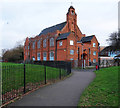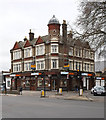1
Noel Park
The Noel Park Estate was built by the Artisan Company between 1881 and 1927. It was specifically designed to provide affordable and fashionable for working class families wishing to leave the inner city. It was designed by Rowland Plumbe and the estate holds some 2,000 properties. Plumbe designed the estate with five different classes of house. Although they vary in size all the houses were designed with front and back gardens. Each of the streets were given their own distinct look.
Noel Park was named after Ernest Noel, Liberal MP and Chairman of the Artisan Company from 1880. The streets were named after board members and people connected to the Artisan Company, as well as prominent politicians of the time - hence Gladstone Avenue and Salisbury Road. Throughout the estate, except for corner houses, each house was built in pairs, with each sharing a porch.
The estate was formally declared open on 4th August 1883 after 200 houses had been completed and another 400 were under construction. A ceremony was held on the site where St Mark's Church now stands. The church was consecrated on 1st November 1889 and by the turn of the 20th century had a congregation twice the size of any other church in Wood Green.
In 1982 in recognition of its architectural and historic interest Noel Park was declared a Conservation Area. This photograph is where Willingdon Road meets Meads Road.
Image: © Marathon
Taken: 8 Apr 2015
0.03 miles
2
The Noel Park Estate
The Noel Park Estate was built by the Artisan Company between 1881 and 1927. It was specifically designed to provide affordable and fashionable for working class families wishing to leave the inner city. It was designed by Rowland Plumbe and the estate holds some 2,000 properties. Plumbe designed the estate with five different classes of house. Although they vary in size all the houses were designed with front and back gardens. Each of the streets were given their own distinct look.
Noel Park was named after Ernest Noel, Liberal MP and Chairman of the Artisan Company from 1880. The streets were named after board members and people connected to the Artisan Company, as well as prominent politicians of the time - hence Gladstone Avenue and Salisbury Road. Throughout the estate, except for corner houses, each house was built in pairs, with each sharing a porch.
The estate was formally declared open on 4th August 1883 after 200 houses had been completed and another 400 were under construction. A ceremony was held on the site where St Mark's Church now stands. The church was consecrated on 1st November 1889 and by the turn of the 20th century had a congregation twice the size of any other church in Wood Green.
In 1982 in recognition of its architectural and historic interest Noel Park was declared a Conservation Area. This photograph is where Willingdon Road meets Meads Road.
Image: © Marathon
Taken: 8 Apr 2015
0.04 miles
3
Former mission hall, Noel Park
Built in c. 1913 as the Walsham-How Mission Hall in Noel Park, now converted into flats. Overlooked by the compilers of the London North volume of the Buildings of England series.
Image: © Jim Osley
Taken: 10 Jan 2017
0.05 miles
4
The exit from Russell Park
The Noel Park Estate was built by the Artisan Company between 1881 and 1927. It was specifically designed to provide affordable and fashionable for working class families wishing to leave the inner city. It was designed by Rowland Plumbe and the estate holds some 2,000 properties. Plumbe designed the estate with five different classes of house. Although they vary in size all the houses were designed with front and back gardens. Each of the streets were given their own distinct look.
Noel Park was named after Ernest Noel, Liberal MP and Chairman of the Artisan Company from 1880. The streets were named after board members and people connected to the Artisan Company, as well as prominent politicians of the time - hence Gladstone Avenue and Salisbury Road. Throughout the estate, except for corner houses, each house was built in pairs, with each sharing a porch.
The estate was formally declared open on 4th August 1883 after 200 houses had been completed and another 400 were under construction. A ceremony was held on the site where St Mark's Church now stands. The church was consecrated on 1st November 1889 and by the turn of the 20th century had a congregation twice the size of any other church in Wood Green.
In 1982 in recognition of its architectural and historic interest Noel Park was declared a Conservation Area. This photograph shows the exit from Russell Park where it leads to Russell Avenue.
Image: © Marathon
Taken: 8 Apr 2015
0.05 miles
5
Russell Avenue, Wood Green
Image: © David Howard
Taken: 20 Jan 2016
0.09 miles
6
Salisbury Road, Noel Park
The Noel Park Estate was built by the Artisan Company between 1881 and 1927. It was specifically designed to provide affordable and fashionable for working class families wishing to leave the inner city. It was designed by Rowland Plumbe and the estate holds some 2,000 properties. Plumbe designed the estate with five different classes of house. Although they vary in size all the houses were designed with front and back gardens. Each of the streets were given their own distinct look.
Noel Park was named after Ernest Noel, Liberal MP and Chairman of the Artisan Company from 1880. The streets were named after board members and people connected to the Artisan Company, as well as prominent politicians of the time - hence Gladstone Avenue and Salisbury Road. Throughout the estate, except for corner houses, each house was built in pairs, with each sharing a porch.
The estate was formally declared open on 4th August 1883 after 200 houses had been completed and another 400 were under construction. A ceremony was held on the site where St Mark's Church now stands. The church was consecrated on 1st November 1889 and by the turn of the 20th century had a congregation twice the size of any other church in Wood Green.
In 1982 in recognition of its architectural and historic interest Noel Park was declared a Conservation Area. This photograph looks along Salisbury Road towards the junction with Hewitt Avenue.
Image: © Marathon
Taken: 8 Apr 2015
0.12 miles
7
The Noel Park Estate
The Noel Park Estate was built by the Artisan Company between 1881 and 1927. It was specifically designed to provide affordable and fashionable for working class families wishing to leave the inner city. It was designed by Rowland Plumbe and the estate holds some 2,000 properties. Plumbe designed the estate with five different classes of house. Although they vary in size all the houses were designed with front and back gardens. Each of the streets were given their own distinct look.
Noel Park was named after Ernest Noel, Liberal MP and Chairman of the Artisan Company from 1880. The streets were named after board members and people connected to the Artisan Company, as well as prominent politicians of the time - hence Gladstone Avenue and Salisbury Road. Throughout the estate, except for corner houses, each house was built in pairs, with each sharing a porch.
The estate was formally declared open on 4th August 1883 after 200 houses had been completed and another 400 were under construction. A ceremony was held on the site where St Mark's Church now stands. The church was consecrated on 1st November 1889 and by the turn of the 20th century had a congregation twice the size of any other church in Wood Green.
In 1982 in recognition of its architectural and historic interest Noel Park was declared a Conservation Area. This photograph is on the corner of Hewitt Avenue and Salisbury Road.
Image: © Marathon
Taken: 8 Apr 2015
0.12 miles
8
Former public house, Frobisher Road
The former "Queen's Head" public house converted into a furniture store.
Image: © Jim Osley
Taken: 21 Feb 2016
0.14 miles
9
Noel Park
Noel Park by Russell Avenue with some improvement work being undertaken
Image: © Shaun Ferguson
Taken: 11 May 2009
0.14 miles
10
Lymington Avenue, Wood Green
Image: © David Howard
Taken: 20 Jan 2016
0.14 miles











